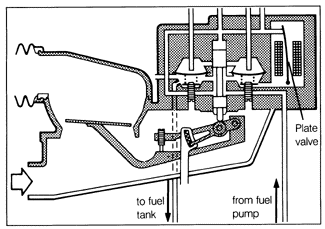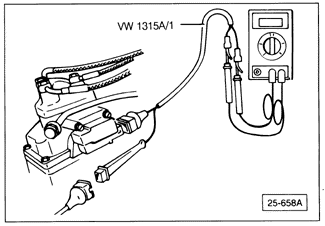Differential Pressure RegulatorThe differential pressure regulator controls pressure in the lower chambers of the fuel distributor, thus controlling the pressure differential across the metering ports and fine-tuning the volume of fuel that is delivered to the injectors. It is operated by the control unit which continuously makes small adjustments based on inputs from the oxygen sensor and other sensors. Fig. 6-17 is a cut-away view of the fuel distributor showing the differential pressure regulator. Information on testing the differential pressure regulator's control of fuel pressure is found in 6.6 Fuel Pressure Tests and Specifications.

The differential pressure regulator is an electro-mechanical valve which responds to changes in electrical current flow. The control unit varies the electrical current flowing in the circuit. In the event that the differential pressure regulator does not receive a signal from the control unit, due to an electrical failure for example, the differential pressure regulator mechanically reverts to a "limp-home" mode-a constant pressure value which will still allow the car to be driven, but perhaps with the engine running roughly. The action of the differential pressure regulator is the single most important factor controlling and adapting fuel mixture. The measurement of differential pressure regulator current is, therefore, the most important and significant means of checking the operation of CIS-E fuel injection. Fig. 6-18 shows the connection of a test harness, Volkswagen special tool no. VW 1315A/1 (order no. TV1 315 OA1 25 ZEL), used to measure differential pressure regulator current. Alternately, a harness can be fabricated to allow hookup of an ammeter as shown in Fig. 6-19.


Complete electrical tests and current specifications are found in 6.4 Electrical Tests (CIS-E) or 6.5 Electrical Tests (CIS-E Motronic). The differential pressure regulator cannot be repaired and if found to be faulty should be replaced. To replace the regulator, remove the harness connector and the two mounting screws. Remove the regulator and the O-rings from the fuel distributor. Installation is the reverse of removal. Install using two new O-rings.
|